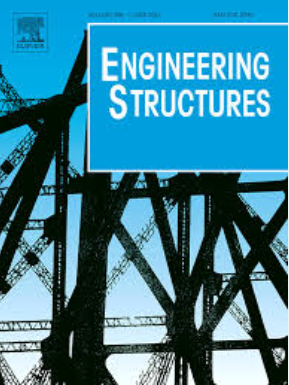双层微模块数据中心振动台试验:结构响应与数值模拟
IF 6.4
1区 工程技术
Q1 ENGINEERING, CIVIL
引用次数: 0
摘要
数据中心是运行物联网、云计算、人工智能等大规模互联网服务的关键基础设施。为了适应对计算能力的要求,世界各地正在建设越来越多的数据中心,包括在高地震烈度地区。然而,数据中心的抗震性能,特别是新开发的微模块数据中心的抗震性能仍然是未知的。本文对双层微模块数据中心模型进行了三轴振动台试验。详细介绍了试验模型的主要组成部分,包括支撑钢架结构和柜内设备、仪表、加载协议等。通过在数据中心模型中安装机柜内设备,直接考虑机柜内设备对数据中心抗震性能的影响。从固有频率、加速度、动力放大系数和变形响应等方面对支撑钢框架的地震损伤和动力特性进行了评价和解释。建立了一个有限元模型,并对该模型的地震反应进行了验证。本文章由计算机程序翻译,如有差异,请以英文原文为准。
Shaking table tests of double-layer micro-module data center: Structural responses and numerical simulation
Data centers are critical infrastructures that run large-scale Internet-based services such as the Internet of Things, cloud computing, and artificial intelligence. To accommodate the requirements on computing power, more and more data centers are being built all over the world including at high seismic intensity areas. However, the seismic performance of data centers, especially the newly developed micro-module data centers are still unknown. In this paper, triaxial shaking table tests on a double-layer micro-module data center model were conducted. The major components of the tested model, including the supporting steel frame structure and inside cabinet equipment, instrumentation, and loading protocols are described in detail. The effects of inside cabinet equipment on seismic performance of the data center were directed considered by installing these equipment in the data center model. The seismic damage and dynamic characteristics of the supporting steel frame were evaluated and explained in terms of the natural frequency, acceleration, dynamic amplification factor, and deformation responses. A finite element model was developed and validated for prediction the seismic responses of the tested data center model.
求助全文
通过发布文献求助,成功后即可免费获取论文全文。
去求助
来源期刊

Engineering Structures
工程技术-工程:土木
CiteScore
10.20
自引率
14.50%
发文量
1385
审稿时长
67 days
期刊介绍:
Engineering Structures provides a forum for a broad blend of scientific and technical papers to reflect the evolving needs of the structural engineering and structural mechanics communities. Particularly welcome are contributions dealing with applications of structural engineering and mechanics principles in all areas of technology. The journal aspires to a broad and integrated coverage of the effects of dynamic loadings and of the modelling techniques whereby the structural response to these loadings may be computed.
The scope of Engineering Structures encompasses, but is not restricted to, the following areas: infrastructure engineering; earthquake engineering; structure-fluid-soil interaction; wind engineering; fire engineering; blast engineering; structural reliability/stability; life assessment/integrity; structural health monitoring; multi-hazard engineering; structural dynamics; optimization; expert systems; experimental modelling; performance-based design; multiscale analysis; value engineering.
Topics of interest include: tall buildings; innovative structures; environmentally responsive structures; bridges; stadiums; commercial and public buildings; transmission towers; television and telecommunication masts; foldable structures; cooling towers; plates and shells; suspension structures; protective structures; smart structures; nuclear reactors; dams; pressure vessels; pipelines; tunnels.
Engineering Structures also publishes review articles, short communications and discussions, book reviews, and a diary on international events related to any aspect of structural engineering.
 求助内容:
求助内容: 应助结果提醒方式:
应助结果提醒方式:


